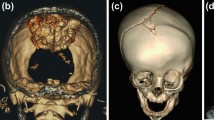Abstract
The brain is our most complex organ, in terms of gross and microscopic structure. It is heterogeneous, with many areas and networks differing from one another in function. And, what is more, the brain is a ‘hidden entity’, embedded in an envelope made of bones, the skull. Brain imaging really came to age in medicine 40 years ago, thanks to computers. The technologies of structural anatomy like computerized tomography and magnetic resonance imaging have brought about a revolution in neurology by showing the lesion and its topography. With most recent developments, neuro-imaging continues to shape practices in neurology and clinical research.



Similar content being viewed by others
References
Ackerman, Sandra L. 2006. Hard science, hard choices. New York: Dana Press.
Amat, Jose A., Richard A. Bronen, Sanjay Saluja, Noriko Sato, Hongtu Zhu, Daniel Gorman, Jason Royal, and Bradley Peterson. 2006. Increased number of subcortical hyper intensities on MRI in children and adolescents with Tourette’ s syndrome, obsessive-compulsive disorder and attention deficit hyperactivity. American Journal of Psychiatry 163: 1106–1108.
Baertschi, Bernard. 2009. La neuroéthique. Ce que les neurosciences font à nos conceptions morales. Paris: La découverte.
Basset, Susan S., David M. Yousem, Catherine Cristinezio, et al. 2006. Familial risk for Alzheimer’s disease alters fMRI activation. Brain 129 (5): 1229–1239.
Brisman, J.L., K. Song, and D.W. Newell. 2006. Cerebral aneurysms. New England Journal of Medicine 355 (9): 928–939.
Drevets, Wayne, J.L. Price, J.R. Simpson, et al. 1997. Subgenual prefrontal abnormalities in mood disorder. Nature 386: 824–827.
Eskandary, H., M. Sabba, F. Kahjehpour, and M. Eskandary. 2009. Incidental findings in brain computed tomography scans of 3,000 head trauma patients. Surgical Neurology 63 (6): 550–553.
Friedman, Jacqueline W., Robin A. Hurley, and Katherine H. Taber. 2006. Bipolar disorder: Imaging state versus trait. The journal of Neuropsychiatry and Clinical Neurosciences 18: 296–301.
Goldman, A.L., L. Pezawas, and V.S. Mattay. 2009. Widespread reduction of cortical thickness in schizophrenia and spectrum disorders and evidence of heredity. Archives of General Psychiatry 66 (5): 467–477.
International Study of Unruptured Intracranial Aneurysms (ISUIA). 1998. Unruptured intracranial aneurysms-risk of rupture and risks of surgical inervention. New England Journal of Medicine 339 (24): 1725–1733.
Javoy-Agid, France, and Yves Agid. 1990. Parkinson’s disease. In An introduction to neurotransmission in health, disease, ed. Peter Riederer, Nicolas Kopp, and John Pearson, 206–220. New York: Oxford University Press.
Klitzman, Robert. 2006. Clinicians, patients and the brain. In Neuroethics. Defining the issues in theory, practice, policy, ed. Judy Illes, 229–244. New York: Oxford University Press.
Kollek, Regine. 2004. Mind metaphors, neurosciences and ethics. In The new brain sciences. Perils and prospects, ed. Dai Rees and Steven Rose, 71–87. Cambridge: Cambridge University Press.
Levy, Neil. 2007. Neuroethics. Challenges for the 21st century. Cambridge: Cambridge University Press.
Logothetis, Nikos K. 2008. What we can do and what we cannot do with fMRI. Nature 453: 869–878.
Mamourian, Alex. 2007. Incidental findings in research functional MRIimages: Should we look? In Defining right, wrong in brain science. Essential readings in neuroethics, ed. Walter Glannon, 134–139. New York: Dana Press.
Nugent, Allison C., Michael P. Milham, and Earle E. Bain. 2006. Cortical anomalies in bipolar disoder investigated with MRI and voxel-based morphometry? Neuroimage 30: 485–497.
Overmeyer, S., E. Bullmore, J. Suckling, A. Simmons, S.C.R. Williams, P.J. Santosh, and E. Taylor. 2001. Distributed grey and white matter deficits in hyperkinetic disorder: MRI evidence for anatomical abnormality in an attention network. Psychological Medicine 31: 1425–1435.
Paloyelis, Y., M.A. Mehta, J. Kuntsi, and P. Asherson. 2007. Functional MRI in ADHD. Expert Review of Neurotherapeutics 7 (10): 1337–1356.
Pence, Gregory E. 2004. Classic cases in medical ethics. Accounts of cases that have shaped medical ethics with philosophical, legal and historical backgrouds. Boston: Mc Graw Hill.
Pollock, R., and I. Kuo. 2004. Neuroimaging in bipolar disorder. URL: http://cme.medscape.com/viewarticle./471366. Assessed 13 July 2009.
Potkin, S.G., et al. 2009. A genome—wide association study of schizophrenia using brain activation as a quantitative phenotype. Schizophrenia Bulletin 35 (1): 96–108.
Raymond, Jean. 2009. Incidental intracranial aneurysms: Rationale for treatment. Current Opinion in Neurology 22 (1): 96–102.
Schneiweiss, Hervé. 2006. Neuroscience et neuroéthique. Paris: Alvik.
Sodickson, Aaron, et al. 2009. Recurrent CT, cumulative radiation exposure, and associated radiation-induced cancer risks from CT of adults. Radiology 251: 175–184.
Stone, Jon, Adam Zeman, Enrico Simonotto, et al. 2007. fMRI in patients with motor conversion symptoms and controls with simulated weakness. Psychosomatic Medicine 69: 961–969.
Toga, Arthur W., Micheal S. Mega, and Paul N. Thompson. 1997. Neuroimaging Alzheimer’s disease. In Neuropathology of dementia, ed. Margaret M. Esiri and James H. Morris. Cambridge: Cambridge University Press.
Truchot, Lydie, S.N. Costes, L. Zimmer, et al. 2007. Upregulation of hippocampal serotonin metabolism in mild cognitive impairment. Neurology 69: 1012–1017.
Vogely, Kai. 2003. Schizophrenia as disturbance of the self construct. In The self in neuroscience, psychiatry, ed. Tilo Kirscher, and Anthony David, 361–379. Cambridge: Cambridge University Press.
Wiebers, D.O., J.P. Whisnant, J. Huston, et al. 2003. International study of unruptured intracranial aneurysms investigators unruptured intracranial aneurysms: Natural history, clinical outcome, and risks of surgical and endovascular treatment. Lancet 362: 103–110.
Acknowledgments
The author wishes to thank Pierre Krolak-Salmon for his neurological expertise, Lara Huber for suggestions and editorial help, Elizabeth Valour for linguistic corrections, Emmanuel Jouanneau for information on neurosurgery, Jean Claude Froment and Francis Turjman for neuroradiology.
Author information
Authors and Affiliations
Corresponding author
Electronic supplementary material
Below is the link to the electronic supplementary material.
Rights and permissions
About this article
Cite this article
Kopp, N. How Technologies of Imaging are Shaping Clinical Research and Practice in Neurology. Medicine Studies 1, 315–328 (2009). https://doi.org/10.1007/s12376-010-0037-1
Received:
Accepted:
Published:
Issue Date:
DOI: https://doi.org/10.1007/s12376-010-0037-1




